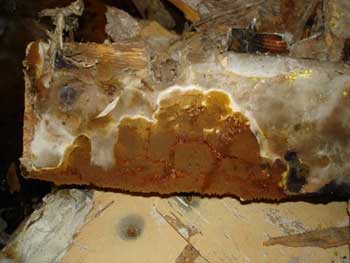Wet Rot - how to diagnose
Wet Rots are extremely easy to confuse with the one and only Dry Rot, so it is important to look for several typical characteristics - a single piece of evidence can be misleading.
If in doubt contact one of our Qualified Timber Surveyors on 01626 872886 and send us some photographs of the site. Try not to destroy the evidence of Wet Rot until a firm diagnosis has been confirmed - you may also wish to advise your Building's Insurers, in case the water that caused the rot came from a leak that may be covered by your Buildings Insurance Policy.
Wet Rot must be taken seriously because it can long term structural damage and insect attack, but unlike Dry Rot, which can travel across dry areas, Wet Rots are entirely limited to the wet area and cannot travel. Always consult a Qualified expert - we can provide Contact Details for PCA Surveying and Contracting Members in your area.
Click to go to Timber Repair Order Page
Wet Rot - main features
Look for these typical parts of the Wet Rot Life Cycle:
1. Strands - called 'hyphae' - like thin tree roots -
from brilliant white to black - flexible when dried out, according to type.
(Unlike Dry Rot, where Strands snap easily when dry).
2. Skin - called 'mycellium' - can be a brilliant white colour to
black (NOT silvery to dirty off white, like Dry Rot).
3. Mushroom - called a 'fruiting body' or 'Sporophore'
- rarely seen in Wet Rots, but never rust red like Dry Rot.
These are Elf Cup, a plaster fungi associated with very wet areas.
4. Dust - called 'spores' - rarely found. But wood boring insect dust is
often found with Wet Rots, especially Wood Boring Weevil,
which leaves tiny, ragged edged holes.
5. Wood shrinkage - called 'cubing' - the wood forms lots of small ,
cubes with a slow loss of volume and sometimes creasing
(unlike Dry Rot which cracks deeply along the wood grain
and forms much large rectangular cubes).
It is unusual to find all of these together in one attack area,
so try to uncover the full extent of the rot and look closely for
each type of symptom. Remember that Wet Rot,
which requires a long term, very high moisture content
can often be found in the same area as Dry Rot simply
because some parts are wetter than others.








